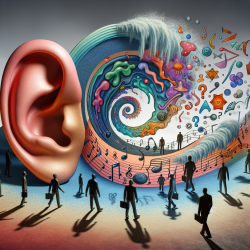Speech perception is a complex process influenced by various factors, including the type of background noise or masker. In environments where multiple people are speaking simultaneously, understanding speech can become particularly challenging. This phenomenon, known as speech-on-speech masking, involves the interference of background speech with the target speech, making it difficult for listeners to comprehend the intended message.
Two primary types of masking affect speech perception: energetic masking and informational masking. Energetic masking occurs when the background noise physically overlaps with the target speech, making it difficult to hear. Informational masking, on the other hand, arises from the similarity between the target and background speech, leading to confusion and difficulty in distinguishing the two.
Researchers have explored various aspects of speech-on-speech masking to understand how different types of maskers influence speech recognition and listening effort. One key factor is the amount of linguistic information in the masker. Maskers with more linguistic content, such as speech babble with fewer speakers, tend to cause greater masking effects compared to non-speech maskers like steady-state noise.
Experiment 1: Speech Recognition Performance
The first experiment aimed to measure speech recognition performance in the presence of different types of maskers. Sixteen participants with normal hearing were presented with sentences in various background conditions, including speech babble maskers with 2 to 8 speakers, time-reversed babble maskers, and speech-spectrum noise (SSN). The signal-to-noise ratio (SNR) required for 50% accuracy (SNR-50) was calculated for each condition.
Results showed that speech recognition performance improved as the number of speakers in the babble masker increased. Maskers with fewer speakers caused greater masking effects, with the 2- and 3-speaker babble maskers resulting in the highest SNR-50 scores. Time-reversed babble maskers caused less masking compared to regular babble maskers, particularly in the 2- and 3-speaker conditions. Interestingly, the 7- and 8-speaker babble maskers resulted in SNR-50 scores similar to the SSN, indicating minimal additional masking from linguistic content.
Experiment 2: Listening Effort Rating
The second experiment focused on measuring the subjective listening effort required to understand sentences in the same masker conditions as Experiment 1. Fifteen participants rated the effort on a 7-point scale while listening to sentences at a fixed SNR of 0 dB. This ensured that all sentences were fully intelligible, allowing for an accurate assessment of listening effort.
Similar to the speech recognition results, listening effort ratings decreased as the number of speakers in the babble masker increased. The 2-speaker babble masker required the most effort, while the SSN required the least. Time-reversed babble maskers generally required less effort than regular babble maskers, highlighting the impact of linguistic content on listening effort.
Implications and Future Directions
The findings from these experiments provide valuable insights into the impact of linguistic information on speech recognition and listening effort. Maskers with more linguistic content, such as speech babble with fewer speakers, pose greater challenges for listeners, both in terms of recognition accuracy and cognitive effort. These results have important implications for real-world listening scenarios, particularly in environments with multiple competing talkers.
Future research should continue to explore the effects of different types of maskers on speech perception, including the use of more ecologically valid stimuli and varying target speech characteristics. Additionally, understanding the mechanisms underlying listening effort and its relationship with speech recognition can help develop strategies to mitigate the challenges faced by individuals with hearing impairments or those in noisy environments.
Overall, the study highlights the need for a comprehensive approach to evaluating speech perception, considering both recognition performance and listening effort. By understanding the interplay between these factors, researchers and clinicians can better address the difficulties encountered in everyday listening situations and improve communication outcomes for individuals in challenging auditory environments.
To read the original research paper, please follow this link: Canadian Journal of Speech-Language Pathology & Audiology.










